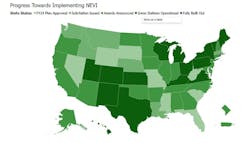The road to an electric vehicle future that could be a key element of a major electrification trend in the U.S. is getting bumpier.
The newest potholes that could slow travel in that direction result from Trump administration efforts to call a time-out on federal programs and rules that have steadily contributed to creation of a more EV-friendly climate.
Exhibit A is a hand grenade tossed into the $5 billion National Electric Vehicle Infrastructure program designed to assist states in building EV charging stations on key nodes of the U.S. highway network. In February, the Federal Highway Administration notified states it was effectively freezing the NEVI program’s funding commitments and undertaking a review of its provisions to ensure they align with emerging administration transportation policy. Sometime this spring, the announcement letter Suspending Approval of State Electric Vehicle Infrastructure Deployment Plans stated, new proposed program guidelines could be issued.
On another front, the administration is making moves to rework vehicle manufacturing requirements designed to reduce tailpipe emissions. The Environmental Protection Agency is moving aggressively to relax such mandates, which have had the effect of incentivizing increased EV production and consumer adoption. Altering those requirements could encourage automakers to continue production of internal combustion engine vehicles for the U.S. market.
Meanwhile, Republican lawmakers in the new Congress they now control, echoing President Trump’s sustained broadsides on EVs, are prioritizing legislation that would scrap or scale back tax credits for electric vehicle purchases, which have helped fuel demand among high-earners. The rich price tag on EVs has emerged as a bigger barrier to broader adoption because an early-adopter cohort less resistant to price is giving way to a much larger pool of more cost-conscious drivers.
All could set EV adoption back, but the NEVI action has the potential to be the most consequential. With ample charging infrastructure emerging as a “must” for many would-be EV buyers, any action that could slow progress on that front could prove damaging to the EV cause. A loss of federal aid through NEVI could be particularly harmful because the program targets high-speed charger installations on major roadways, many that cut through regions with low EV-charging penetration.
Since NEVI funding began flowing to states in 2022, around 65% of the $5 billion pot has been allocated to states through a proscribed funding formula. But of that $3.3 billion, only around $500 million had been awarded by the states for projects and only $40 million had been spent as of early February, a NEVI status of funds document shows (See Table).
That gap has translated to little actual progress on the program’s goal of building 500,000 EV charging stations by 2030. A February story in InsideEVs, citing a source that tracks charging data – Paren – said there were 51 active NEVI stations in 14 states outfitted with 224 charging ports. By that source’s calculation, that left about $615 million committed federal dollars left to be spent by states to help bring 999 stations with 4,600 charging ports online. States are in varying states of progress on taking advantage of the NEVI program (See Photo).
Potentially at risk in the highway administration’s review of NEVI are funds that have been allocated but remain unobligated. The NEVI status of funds tally in early February put that number at around $2.7 billion. Whether a change in the program would affect that component as well as any of the balance of the $5 billion still to be allocated in future funding rounds is unknown.
Also unclear is whether the agency’s action will withstand a court challenge. Several groups have sued to block some administration executive orders and resulting agency actions on the grounds that they seek to illegally reverse earlier Congressional funding decisions, among others.
While FHA’s aim in going back to the drawing board with NEVI is unclear, the betting is likely on the side of scaling it back to align with the administration’s dim view of EVs. Fewer federal dollars would make it harder for states to do their essential parts in helping construct a system of chargers whose sum – nationwide charging coverage along key thoroughfares – is greater that its parts.
States may already be bracing for the worst. Unsure of the scope of possible changes and leery of making spending commitments that might hinge on the receipt of federal dollars, some state transportation agencies are suspending rollout plans. Vermont and Michigan are reportedly among them, their agency spokespersons quoted in an MSN News story as saying a pause was in order despite a lack of clarity on what’s impacted by the FHA’s recission order. Some others, however, say they’re moving ahead, at least with projects that are funded and already in the pipeline.
About the Author
Tom Zind
Freelance Writer
Zind is a freelance writer based in Lee’s Summit, Mo. He can be reached at [email protected].


